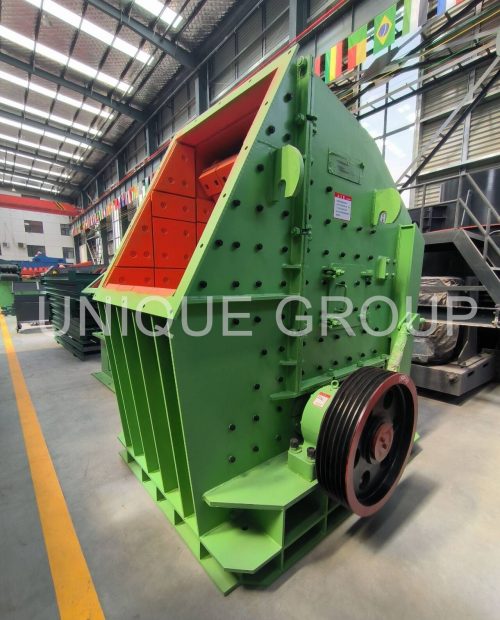In the thunderous world of mineral processing and quarrying, impact crushers reign supreme as essential workhorses. These mighty machines pulverize mountains of rock, concrete, and ore through brute force – rapid impacts delivered by spinning rotors equipped with heavy hammers or blow bars. Amidst the apparent chaos of colliding steel and shattering stone, a seemingly humble component plays a critical, often overlooked role: the crusher spring. Far more than just a passive piece of metal, this ingenious element is the silent guardian ensuring the crusher’s survival, efficiency, and reliability.

Imagine a blow bar striking a massive boulder. The reaction force is immense, threatening to violently recoil through the rotor assembly, bearings, and frame itself. This is where the spring becomes indispensable. Primarily located within the impact aprons adjustment system and sometimes within the rotor locking mechanisms, springs serve multiple vital functions:
Core Function: When a blow bar impacts feed material, colossal reactive forces surge backward. Without mitigation, these forces would directly transmit through the impact aprons (or breaker plates) into the crusher’s frame and bearings, causing catastrophic fatigue, cracks, and premature failures.
Spring Action: The springs, strategically positioned behind the aprons, instantly compress under this immense load. This compression acts like a cushion, absorbing and dissipating a significant portion of the shock energy generated by each impact.
Physics in Action: The spring leverages Hooke’s Law (F = kx). The force (F) it exerts against the recoiling apron is proportional to its stiffness (k) and the distance compressed (x). This controlled resistance transforms potentially destructive kinetic energy into temporary potential energy stored within the deformed spring. As the force subsides, the spring releases this energy by pushing the apron back towards its working position, ready for the next impact.
Result: The crushing chamber’s integrity is preserved, bearings are shielded from excessive shock loads, and the entire structure experiences significantly reduced stress, dramatically extending operational life.
Core Function: The gap between the rotor’s tips and the impact aprons is paramount. It defines the maximum product size (setting). However, the violent impacts and vibration inherent to crushing constantly threaten to loosen locking mechanisms or cause components to shift.
Spring Action: Springs within the apron adjustment mechanism exert a constant, controlled force. This preload keeps the aprons firmly pressed against their locking cylinders or adjustment rails.
Crucial Role: This persistent spring force ensures the desired gap setting is actively maintained, resisting the tendency for components to back off or shift during operation. Consistent product sizing relies heavily on this spring-induced stability. Without it, the gap could widen unpredictably, leading to oversized product or even equipment damage if components shift drastically.
Core Function: Impact crushing is inherently rhythmic – blows occur dozens of times per second as rotor hammers pass the aprons. This generates significant harmonic vibrations. If unaddressed, these vibrations can resonate through the frame, causing noise, discomfort, accelerated wear on all components (bearings, motors, structures), and even structural fatigue failure.
Spring Action: While primarily there for shock absorption, the spring-mass system formed by the aprons and their backing springs inherently acts as a vibration damper.
Energy Conversion: The springs continuously absorb kinetic energy from the vibrating aprons, convert it briefly to potential energy, and release it gradually. This process disrupts the coherence of the vibration waves, dissipating energy as heat within the spring material and significantly reducing the amplitude of transmitted vibrations throughout the machine.
Core Function: Foreign, uncrushable objects (tramp iron, large steel fragments, bucket teeth) inevitably find their way into crushers. Attempting to crush these yields enormous, potentially catastrophic forces.
Spring Action: The springs behind the impact aprons provide a deliberate “weak link” or sacrificial yielding point. When force exceeds the spring’s preload and compression capacity, the springs allow the aprons to swing open or lift upwards significantly
.Safety Release: This crucial movement dramatically enlarges the crushing gap, allowing the uncrushable object to evacuate the chamber rather than shattering expensive blow bars, destroying the rotor, or tearing the crusher apart.
Reset: Once the obstruction passes, the springs immediately pull the aprons back to their original, pre-set position, allowing normal operation to resume with minimal downtime. This function is arguably the spring’s most vital safety role.
Understanding these functions translates directly to real-world crusher performance and maintenance:
Within the roaring heart of an impact crusher, where forces are measured in tons and survival is a constant battle against inertia, the spring stands as a paragon of elegant engineering. It transforms destructive violence into controlled motion, ensuring the machine not only survives its brutal task but thrives within it. Far from a simple component, the crusher spring is a master of energy manipulation – absorbing, storing, releasing, and dissipating – acting as the indispensable, resilient core safeguarding the power and productivity of these industrial titans. Its silent, relentless work is fundamental to turning mountains of rock into the building blocks of our world.